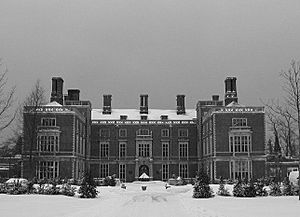Webb Institute facts for kids
 |
|
| Type | Private college |
|---|---|
| Established | 1889 |
| Endowment | $62.6 million (2020) |
| President | Mark Martecchini |
|
Academic staff
|
10 |
| Undergraduates | 98 |
| Location |
,
,
United States
|
| Campus | Suburban, 26 acres (11 ha) |
| Nickname | Webbies |
Webb Institute is a special private college in Glen Cove, New York. It focuses on engineering, especially for ships. Students who graduate from Webb get a degree in naval architecture and marine engineering. This means they learn how to design, build, and operate ships. The school is well-known for teaching students about ship design, how different ship systems work, and giving them real-world experience. A great thing about Webb is that U.S. students don't pay tuition.
Contents
History of Webb Institute
Webb Institute was started in 1889 by a rich businessman named William Henry Webb. He was a very famous shipbuilder in the 1800s. William Webb saw that science and engineering were becoming super important for designing ships. Before, ship design was often seen more like an art. But Webb believed that future ship designers would need strong skills in engineering and other sciences. The first students graduated in 1893. Since then, Webb Institute has continued to teach students about naval architecture and marine engineering.
How Webb Institute Began
On April 2, 1889, Webb's Academy and Home for Shipbuilders officially became a non-profit school in New York. William Webb gave the academy enough money to run forever on its own. He wanted it to be a school for future ship designers. It was also meant to be a retirement home for older shipbuilders.
Webb hired an architect named Arthur P. Jennings to design the school building. It was built on about 14 acres of land in the Bronx, overlooking the Harlem and Hudson rivers. Construction started in 1890 and finished in 1893. The building looked like a "romantic medieval castle." It had towers, fancy carvings, and was made of New York brownstone. This building was used by the school for 50 years.
During World War II, Webb Institute worked closely with the U.S. Navy. It became a training center for naval officers.
Moving to a New Campus

By 1945, the school's leaders decided the Bronx campus was not good enough anymore. It didn't have the right labs. So, they sold it for a lot of money. The old site was later turned into apartment buildings.
In November 1945, Webb Institute bought its current home. This was The Braes, a large country estate in Glen Cove, New York. It was once owned by Herbert L. Pratt. The main house was built between 1912 and 1914. It had a unique H-shape and looked like a mix of old English and European styles. It was the biggest of the six Pratt family estates in Glen Cove. Work to change the estate into a school began in 1946.
In April 1947, classes started at the new campus in Glen Cove. The main building was updated to have classrooms, dorms, and offices. A special pool for testing ship models and a gym were built nearby. The main building was renamed Stevenson Taylor Hall. This was to honor Stevenson Taylor, who was a leader of the school's board for many years. The first floor of Stevenson Taylor Hall still looks much like it did in 1915.
A modern library and an auditorium were added to the campus in 1971. In 1974, Webb Institute started admitting women as students for the first time.
The Webb Institute campus has been used in several movies and TV shows. It was the outside of Wayne Manor in the 1995 movie Batman Forever. It was also used in Batman & Robin (1997) and the TV series Gotham (2014). The school appeared as Wayne Manor again in the 2019 movie Joker. It was also in the 1998 film Great Expectations. Inside and outside shots were seen in the TV series Limitless in 2015.
What Students Learn at Webb
Webb Institute usually has about 90 students. About 20% of them are female. The school has 12 full-time teachers and no teaching assistants. Students can easily talk to their professors, who are often available for help. Some humanities classes, like Political Philosophy, are taught by teachers from other local colleges.
There are four classrooms, one for each year group. Unlike most schools, the professors move to different classrooms, not the students. The front of the classroom is for lectures. The back has drafting tables for each student, plus bookshelves and couches. This gives students a personal study space they can use anytime.
A very important part of Webb's learning facilities is its 90-foot-long model ship model basin. Students and teachers often use this pool for experiments and research. Webb Institute also has its own physics and chemistry labs. There is a large library, an engineering lab for experiments, a carpentry shop, and a machine shop. Students can use these facilities almost any time. Webb's programs really focus on hands-on learning. Many classes require students to do experiments or build and test models.
The classes at Webb Institute are challenging. Students spend up to 5 hours a day in lectures. They also spend many hours working on their own outside of class. Every year, from January to February, students must do a mandatory internship. They work in places like shipyards, design offices, or on merchant ships. All senior students must complete a senior thesis. Seniors are also strongly encouraged to take the Fundamentals of Engineering exam, where they usually do very well.
About 85% of students who start at Webb end up graduating. Many graduates find jobs in the maritime industry. In fact, 100% of graduates get jobs. Graduates also work in other engineering fields or find success in finance or law. About one-third of each graduating class goes on to get a higher degree. Webb has a strong alumni association. This group supports graduates, helps them connect, and raises money for the school. Over 70% of alumni donate money, which is one of the highest rates in the United States.
Because of the money given by the founder and the high rate of alumni donations, U.S. citizens do not pay tuition at Webb. Students only pay for their room and board, books, and other small fees. Students earn their Bachelor of Science degree after four years of "total immersion" study. This includes several months of job experience through internships.
The institute works closely with the nearby United States Merchant Marine Academy and State University of New York Maritime College. It also has ties with Cooper Union.
Winter Work Internships
"Winter Work" is what Webb Institute calls its special internship periods. Webb students must work in different parts of the marine industry for 8 weeks. This happens during January and February each year. First-year students work as helpers or mechanics in shipyards. Second-year students work as observers on ships at sea. Third and fourth-year students do internships in engineering and design offices. By the time students graduate, they have 8 months of real work experience. Recently, Winter Work has become more global. Some students travel overseas to countries like China, the Netherlands, and Greece.
School Accreditation
Webb Institute is approved by the Middle States Commission on Higher Education. The Naval Architecture and Marine Engineering program is also approved by the Engineering Accreditation Commission of ABET. This means their programs meet high quality standards.
Student Life and Activities
Living on Campus
Students usually live on campus for all four years. Webb Institute does not have fraternities or sororities. There is a student-run Social Committee at Webb. This group plans parties and trips off campus throughout the year.
The Honor Code
The students at Webb follow an Honor Code. This code means they promise not to lie, cheat, or steal. The Student Organization helps manage the Honor Code. It also handles student money, plans social events, and connects students with the school's leaders.
Fun Activities and Sports
Webb has five sports teams that play against other colleges. They have sailing all year. In the fall, they play soccer and basketball. In the spring, they play volleyball and tennis.
Students have many ways to have fun during their studies. The school has its own yacht club, a workshop for cars, and even an English pub. Besides the intercollegiate sports, students can also play sailing, tennis, soccer, volleyball, ultimate, and basketball. New York City is only about an hour away by train. There are also many student-led clubs on campus, both for sports and for learning.
Webb won the 2018 HVIAC men's tennis championship. This was the first championship Webb sports had won in recent history.
Webb Institute Athletics
The sports teams at Webb are called the Webbies. The institute is part of the United States Collegiate Athletic Association (USCAA). This started in the 2023–24 school year for most sports. Their sailing team competes in the Middle Atlantic Intercollegiate Sailing Association (MAISA). Before this, the Webbies played in the Hudson Valley Intercollegiate Athletic Conference (HVIAC) from 2004–05 to 2023–23.
Webb competes in five college-level sports: basketball, sailing, soccer, tennis, and volleyball for men.
Famous Graduates
- Bill Langan, a yacht designer
- Norman B. Hall, a U.S. Coast Guard admiral
- Halsey Chase Herreshoff, a yacht designer
- David M. Young Jr., a mathematician
- Lloyd M. Trefethen, an inventor and fluid mechanics researcher
- Alfred Zeien, former CEO of Gillette
See also
- Association of Independent Technological Universities
- Hudson Valley Intercollegiate Athletic Conference


